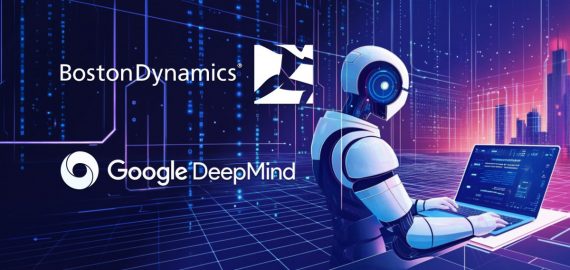McKinsey’s Detailed Analysis: The Future Path of Real-World Asset Tokenization Within Financial Markets


In Brief
McKinsey & Company’s report suggests slower adoption of tokenization of real-world assets, with potential ramifications for the financial sector.
A recent report by McKinsey & Company suggests that the adoption of tokenization of real-world assets (RWAs) may be slower and more limited than some optimistic predictions have suggested. Here, we’ll look at McKinsey’s view on tokenized RWAs going forward, assess the market’s present situation, and speculate on possible ramifications for the financial sector.
Current State of RWAs in 2024
Although real-world asset tokenization is still in its initial stages as of 2024, there are indications of increased acceptance and interest. As to the statistics provided by Coingecko, the RWA market is currently valued at more than $8.4 billion in total. Large financial firms are starting to make an appearance in the market. BlackRock, the biggest asset management in the world, introduced BUIDL, a tokenized fund, on the Ethereum network.
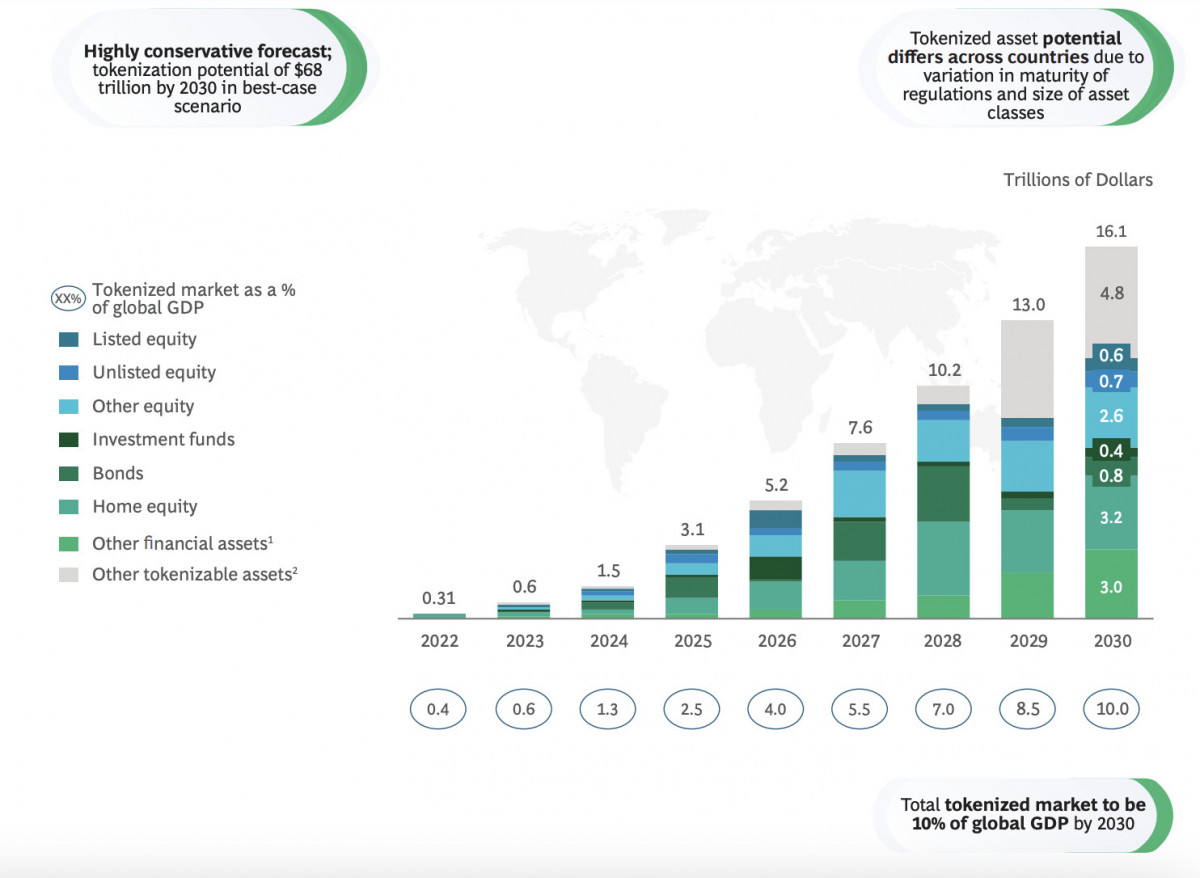
Photo: BCG X ADDX
Various asset types, such as bonds, mutual funds, real estate, and commodities, are undergoing tokenization projects. While regulatory clarity is still a problem in many sectors, regulators across the board are striving to create frameworks for tokenized assets. Businesses are creating platforms and protocols to facilitate the issuance, trading, and administration of tokenized RWAs.
Tokenizing real-world assets is an ongoing endeavor and business at the moment. These comprise MakerDAO, Untangled Finance, Swarm Markets, Ondo Finance, Mantra, Polymesh, OriginTrail, Pendle, and TokenFi. These initiatives are all focused on different facets of RWA tokenization, ranging from use cases or asset classes to infrastructure development.
McKinsey’s Forecast in a Nutshell
In the best case scenario, the market for tokenized assets might grow to over $2 trillion by 2030, according to a McKinsey analysis. Compared to some other industry forecasts that have predicted values many times higher, this estimate is much lower.
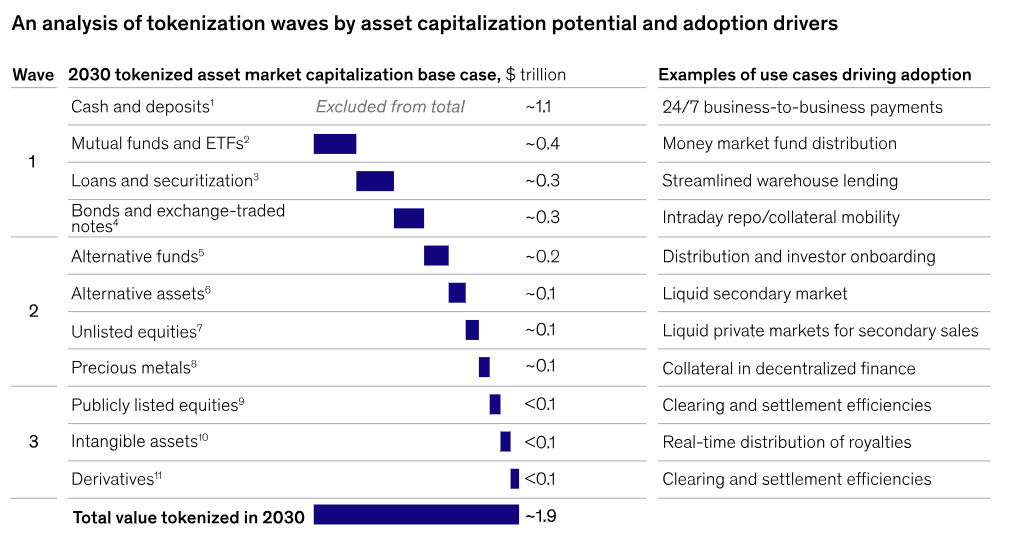
Photo: McKinsey
Based on the assumption that financial institutions would adopt blockchain for conventional financial tools more slowly and over a smaller range of assets than initially projected, McKinsey has adopted a more conservative perspective.
The research outlines three potential trajectories for the growth of tokenized assets. By 2030, under the base scenario, the market is anticipated to achieve a valuation of $2 trillion.
In contrast, the pessimistic outlook suggests a market size of only $1 trillion, while the optimistic scenario posits a more ambitious projection of $4 trillion. It’s important to note that McKinsey’s forecasts exclude tokenized deposits, stablecoins, and CBDCs from their estimations.
Key Findings from McKinsey’s Report
According to McKinsey, tokenization is poised to reach a turning point in technology as a number of projects transition from test markets to mass market acceptance. The top industries influencing the uptake of tokenization projects include stocks, bonds, mutual funds, exchange-traded notes, repurchase contracts, alternative funds, mortgages, and securitization.
It is anticipated that assets like stocks, commodities, and real estate would be adopted more slowly because of things like marginal advantages, practicality issues, complicated compliance requirements, and a lack of incentives for major sector participants. The paper identifies a number of obstacles to broad adoption, such as the requirement for infrastructure development, industry-wide cooperation, and regulatory clarity.
Being the first in a new technological sector comes with dangers, but early adopters of tokenization may be positioned to acquire an “oversized” market share.
Factors Influencing Adoption of RWAs
The McKinsey paper lists a number of variables that will affect the uptake of tokenized RWAs. For broad adoption, the creation of transparent and encouraging regulatory frameworks will be essential. It will be crucial for blockchain technology to be able to handle large transaction volumes and system compatibility.
One key facilitator will be the broad availability of tokenized currency for immediate settlement. The industry will flourish as long as institutional investors are willing to spend money on tokenized products on a large scale. To build sustainable ecosystems for tokenized assets, financial institutions, market infrastructure providers, and technological businesses will need to collaborate.

Photo: McKinsey
In spite of the cautious growth forecasts, McKinsey’s analysis recognizes a number of possible advantages of tokenization. These include the capacity to utilize smart contracts for programmability, enhanced transparency, fractional ownership options, higher liquidity, and operational efficiency.
However, the paper also draws attention to a number of dangers and difficulties associated with using tokenized RWAs. These include the requirement for market adoption among conventional investors and institutions, regulatory uncertainty, potential market fragmentation, technological integration challenges, and security concerns.
Implications of RWAs for the Financial Industry
The sphere is affected in a number of ways by the tokenized RWAs’ slower-than-anticipated adoption, according to McKinsey’s projections. It is probable that the transition to tokenized assets will occur gradually, instead of abruptly upending current systems. Where the advantages are greatest, financial institutions may concentrate on tokenizing particular asset classes or use cases.
Tokenized assets will probably survive with conventional financial instruments for some time to come, necessitating the need for systems that can connect the two. Tokenization technologies and business models may have more time to be tested and improved as a result of the slower adoption rate.
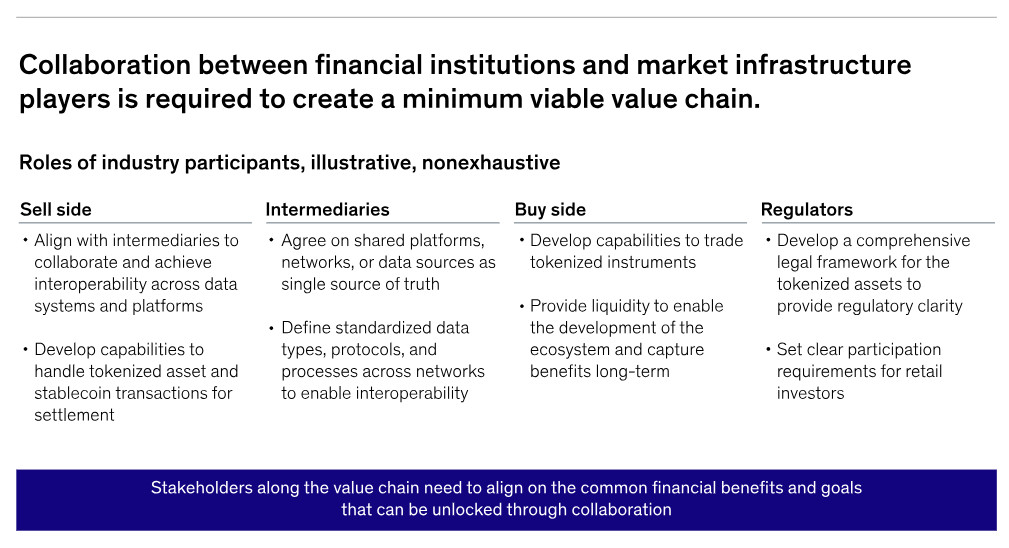
Photo: McKinsey
The market positioning and experience of early adopters in the tokenization arena may provide them with benefits, while later adopters may gain from better developed technology and more transparent legal frameworks.
The Future of RWAs
Compared to certain industry forecasts, McKinsey’s expectation of $2 trillion in tokenized RWAs by 2030 represents a more conservative perspective. Although this number implies a considerable increase over the existing market size, it also suggests that tokenized assets may not become widely adopted as quickly as some enthusiasts had hoped.
The CEO of BlackRock, Larry Fink, said that tokenization of assets will be a feature of the future generation of securities and markets.
One potential use of blockchain technology in the financial industry is the tokenization of physical assets. However, to reach its full potential, a number of obstacles must be overcome, including technological integration problems, market acceptability concerns, and regulatory barriers.
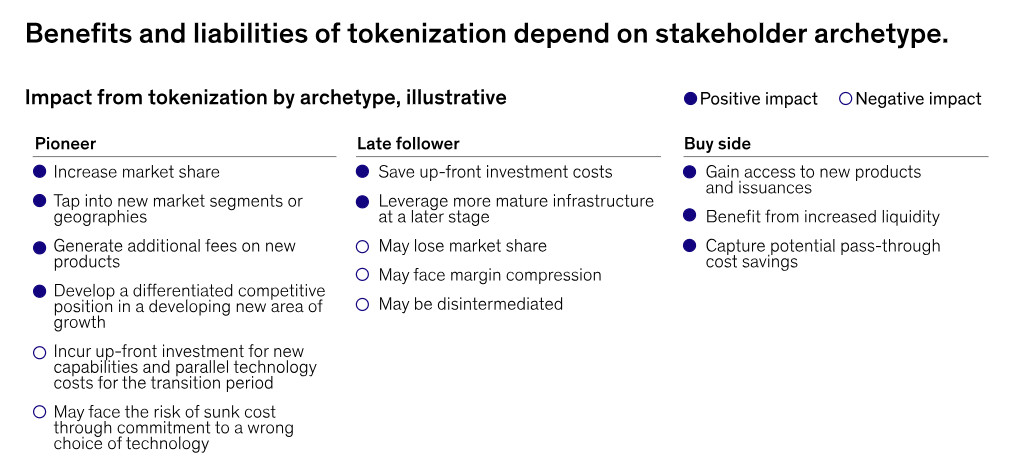
Photo: McKinsey
The success of tokenized RWAs in overcoming present challenges and finding the potential for improved accessibility, liquidity, and efficiency in the financial markets will be determined in the upcoming years.
Disclaimer
In line with the Trust Project guidelines, please note that the information provided on this page is not intended to be and should not be interpreted as legal, tax, investment, financial, or any other form of advice. It is important to only invest what you can afford to lose and to seek independent financial advice if you have any doubts. For further information, we suggest referring to the terms and conditions as well as the help and support pages provided by the issuer or advertiser. MetaversePost is committed to accurate, unbiased reporting, but market conditions are subject to change without notice.
About The Author
Victoria is a writer on a variety of technology topics including Web3.0, AI and cryptocurrencies. Her extensive experience allows her to write insightful articles for the wider audience.
More articles

Victoria is a writer on a variety of technology topics including Web3.0, AI and cryptocurrencies. Her extensive experience allows her to write insightful articles for the wider audience.














































